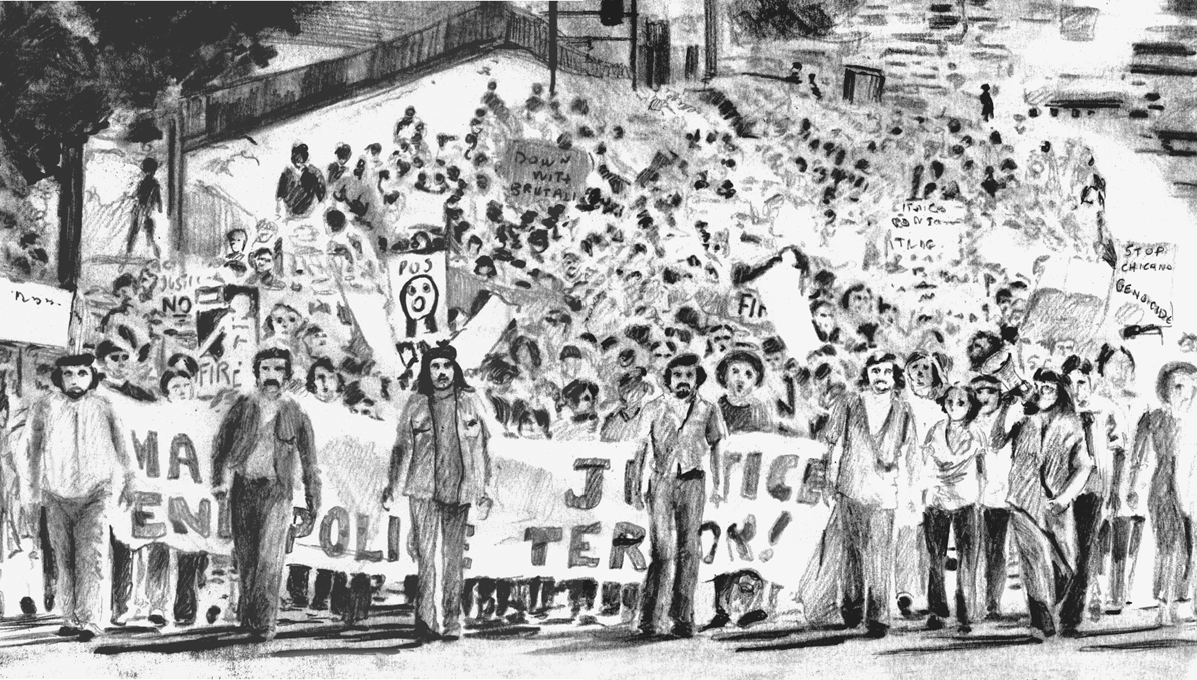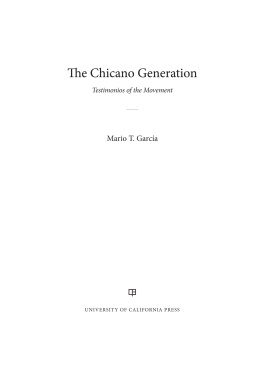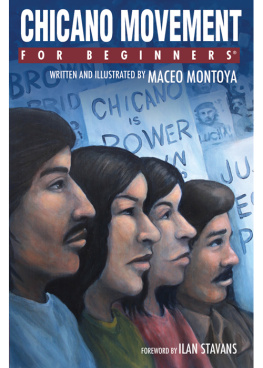SANCHOS JOURNAL
Jack and Doris Smothers Series in Texas History, Life, and Culture Number Thirty-three
DAVID MONTEJANO
ILLUSTRATIONS BY MACEO MONTOYA
SANCHOS JOURNAL

Brown Berets from San Antonio, Dallas, and Austin, lead a protest to the State Capitol, Austin, October 11, 1974; based on photo by Alan Pogue
UNIVERSITY OF TEXAS PRESS  AUSTIN
AUSTIN
Publication of this work was made possible in part by support from the J. E. Smothers, Sr., Memorial Foundation and the National Endowment for the Humanities.
Copyright 2012 by the University of Texas Press
All rights reserved
Printed in the United States of America
First edition, 2012
Requests for permission to reproduce material from this work should be sent to:
Permissions
University of Texas Press
P.O. Box 7819
Austin, TX 78713-7819
utpress.utexas.edu/about/book-permissions
LIBRARY OF CONGRESS CATALOGING-IN-PUBLICATION DATA
Montejano, David, 1948
Sanchos journal : exploring the political edge with the Brown Berets / by David Montejano ; illustrations by Maceo Montoya. 1st ed.
p. cm. (Jack and Doris Smothers series in Texas history, life, and culture)
Continues: Quixotes soldiers.
Includes bibliographical references.
ISBN 978-0-292-74239-0 (cloth : alk. paper) ISBN 978-0-292-74384-7 (pbk. : alk. paper)
1. Mexican AmericansTexasSan AntonioHistory20th century. 2. Mexican AmericansTexasSan AntonioPolitics and government20th century. 3. Mexican AmericansTexasSan AntonioBiography. 4. Chicano movementTexasSan Antonio. 5. San Antonio (Tex.)Race relationsHistory20th century. 6. San Antonio (Tex.)Politics and government20th century. I. Montejano, David, 1948Quixotes soldiers. II. Title.
F394.S2119M51737 2012
305.8968720764351dc23
2012016105
ISBN 978-0-292-74240-6 (e-book)
ISBN 978-0-292-74241-3 (individual e-book)
doi:10.7560/742390
Pa los batos y rucas del Condado de Bxar
que sigan soando de mejores mundos!
c/s
Among other things, Don Quixote said that [Sancho Panza] should prepare to go with him gladly, because it might happen that one day he would have an adventure that would gain him, in the blink of an eye, an nsula, and he would make him its governor.
MIGUEL DE CERVANTES, DON QUIXOTE, FIRST PART, CHAPTER VII
C ONTENTS
P REFACE AND ACKNOWLEDGMENTS
This Journal tells two stories. One is an account of my experience with a Brown Beret chapter, the Southside Berets of San Antonio, Texas, in the mid-seventies. The narrative is based on my journal notes written while hanging out with a dozen or so street men or batos locos (crazy guys) in 19741975, with various addenda tacked on over the years. I was interested in understanding how they acquired political consciousness and how such consciousness transformed behavior. Seven months of hanging out, coupled with intensive interviews, proved to be sufficient to develop a snapshot of the politicization process. I came to understand the manner in which these batos adapted their lifestyle and habits to accommodate their entry into the public arena of politics. A follow-up some thirty years later confirmed various features of that snapshot.
Interwoven into this account is a second storymy explanation of why it took more than thirty years to write this up. Basically this was a failed dissertation. Explaining that failure, and resolving it, is an integral part of the following narrative. My observations and note taking, in other words, did not stop once I left the barrio settings. The notes spill over to record the various academic settings and interactions that gave final shape to this dissertation project over time. They describe my search for an appropriate conceptual framework for my experience with the Berets. This journal, then, is an intellectual autobiography of sorts. It brings closure to a line of inquiry that began some three decades ago.
I have many people to thank for a project that has lingered for so many years. All those I acknowledged previously in my history of the Chicano movement, Quixotes Soldiers: A Local History of the Chicano Movement, 19661981 (University of Texas Press, 2010), deserve another round of thanks for this companion ethnography. Drawing from that list, I again thank those who engaged me in discussion and supportive critique at some critical pointDiana Montejano, Mario Compean, Martn Snchez Jankowski, David Montgomery, Emilio Zamora, Tobas Durn, Felipe Gonzales, Richard Fox, Carlos Vlez-Ibez, Ben Olgun, and Vernica Garca. For their reading of several manuscript chapters, I thank the members of my history writing group (spring 2010)Alex Garca, Filiberto Chvez, Jordan Gonzales, Natalie Mendoza, and Joe Orbock. For their close scrutiny of the entire manuscript, I am most grateful to David Minkus and Andrs Jimnez.
Naturally I am especially indebted to the Southside Berets for allowing me to hang out with them. I am indebted as well to the leadership of the Valley, Austin, Waco, and Dallas chapters for their candid views. Because I have disguised their identities, I can only give them a collective gracias. My decision to maintain their anonymity also meant that any illustrations had to be drawings rather than photographs. Half of the following illustrations have been abstracted from photographs, with the remainder reconstructed from my journal notes and memory. Artist Maceo Montoya, son of Chicano movement artist and activist Malaquas Montoya, drew the exquisite charcoal line drawings that accompany the narrative. I am deeply appreciative of his interpretive skills and patience. Maceos work is a powerful suggestion of the continuity of Chicano movement culture and practice. Finally, I thank John Ledesma for last-minute edits of some images.
In closing, I gratefully acknowledge the various academic patrons whose financial support basically kept this project alive. Research grants from the University of New Mexico, the University of Texas at Austin, and the University of California, Berkeley, provided important life support for this project. Of special note were sabbatical residencies at the School of American Research in Santa Fe, New Mexico, and the Center for the Advanced Study of the Behavioral Sciences in Stanford, California. In conclusion, I extend un abrazo firme to the University of Texas Press staff, particularly editor Theresa May, for their support over many years.
I alone, of course, am responsible for the following interpretation.
Berkeley, California
June 19, 2011
SANCHOS JOURNAL
O N SLOW WRITING
Some thirty years ago, when I was searching for a dissertation topic, I carried out an ethnographic study of a Brown Beret chapter that formed during the Chicano movement of the late sixties and early seventies. For seven months in 19741975, I hung out with a group of thirteen young men as they learned about the Berets and the Chicano movement. I was interested in understanding how they acquired political consciousness and how such consciousness transformed behavior. If I could somehow capture the essence of becoming political, I reasoned at the time, then perhaps that essence could be reproduced and disseminated. And what better material could I have to search for that political essence than the working- and lower-class street youths who were marching and protesting and calling themselves Brown Berets?







 AUSTIN
AUSTIN